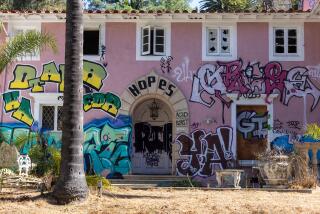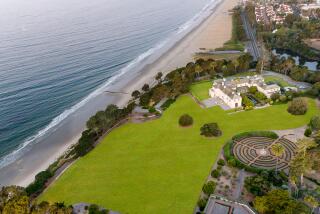On a Hilltop in La Canada, His Home Is Truly His Castle
- Share via
Mere real estate it definitely is not.
Perched on an oak-studded hillside of La Canada Flintridge, a massive stone castle rises like a mirage from a Brothers Grimm fairy tale or a Shakespeare play.
With its fanciful turret, imposing stone facade and rolling green lawns, the gray castle bespeaks medieval times, knights, white horses and damsels in distress. Even the castle tower looks like the one where Rapunzel might have let down her hair.
The man who built it was a politician, as idealistic and hopeful as any Prince Charming off to win his lady fair. But the man who lived in it the longest was a hard-nosed real estate developer and the crony of a scandal-plagued U.S. president.
For nearly a century, the four-story, 9,000-square-foot castle has been one of Southern California’s most overlooked landmarks and one of La Canada Flintridge’s best-kept secrets. Its inaccessibility has been fortified by mystery and scandal, its story often known only through a web of rumors.
Over the decades, all but one of the castle’s original 75 acres have been gradually sold off and subdivided into upscale, maze-like neighborhoods below. For about 70 years, locals also called it the “Pink Castle,” after an angry wife painted it the color of Pepto-Bismol as revenge on her husband’s poor taste in friends.
The surrounding hillside and canyon is much more lush now than it was in 1911 when Lt. Gov. Albert Joseph Wallace and his wife, Alice, built the storybook fortress. Only dirt, sagebrush and wild grapevines covered the slopes back then.
The castle began as a summer retreat modeled after Skibo Castle in the Scottish Highlands, once the home of Scottish-born steel tycoon Andrew Carnegie. Now it’s known as the Carnegie Club; it was the site of Madonna’s last wedding reception.
Wallace’s place in history comes less from his political career than from his real estate ventures. He developed the affluent West Adams Heights area in 1901. As an oil and land magnate, banker and politician, he served on the Los Angeles City Council from 1907 to 1909.
But Wallace, a devout Methodist, grew disgusted with rampant graft and corruption. In 1910, he rode the wave of public discontent into Sacramento on the same reform ticket as Gov. Hiram Johnson, becoming lieutenant governor. Wallace, a Republican teetotaler and president of the Anti-Saloon League of California, captured the votes of temperance supporters, who were powerful in Southern California. Both Wallace and Johnson pledged to slam the door on “political machines and special interests” by giving voters the referendum, the initiative process and the recall.
Before leaving for Sacramento, Wallace bought 75 acres in the foothills of the San Gabriels, in what was then a poor, scrubby area populated mostly by farmers, health seekers and vineyards. To build his dream castle, he hired architect Arthur B. Benton -- whose credits include the landmark Mary Andrews Clark YWCA in Los Angeles, the San Gabriel Civic Auditorium and the Mission Inn in Riverside (where he was one of the designers).
The castle took shape in concrete and stone, with balustrades and marble floors, oak paneling, hidden passageways, leaded and stained-glass windows, and 2-foot-thick walls to keep it cool and subdued.
Wallace called it “El Nido,” meaning the nest. He even had a quaint little lake installed for canoeing. The Scottish-motif, thistle-carved ceiling friezes in the living room and fireplace mantle are still evident.
The castle became part of local lore and legend, and Wallace himself would often figure in a legend of his own: He was frequently confused with Gen. Lew Wallace, governor of the New Mexico Territory from 1878 to 1881. That Wallace promised amnesty to Billy the Kid, then put a $500 reward on his head.
He also wrote the immensely popular 19th century religious novel “Ben-Hur,” on which at least three films were based.
But even in the castle’s fair setting, and despite its grand view that stretched to Catalina on a clear day, Alice Wallace hated the place. She complained that she couldn’t find local people of any breeding or social stature, let alone equal to her own, to socialize with in La Canada.
In 1914, at his wife’s pleading, Wallace sold the castle to real estate mogul Frank Raleigh Strong. Strong was a crony of President Warren G. Harding, according to the present owner, George G. Strong Jr. (no relation to the other Strong), who is managing director and general counsel of Cornerstone Research, a litigation-consulting firm with offices in downtown L.A. George Strong did extensive research on the castle’s history after he bought it in 1992.
During Harding’s six years in the U.S. Senate before he was elected president in 1920, he was a frequent visitor to Southern California. His sister lived in Santa Ana and Harding was a member of the Newport Yacht Club. He was also a big drinker and an avid golfer and poker player who had a roving eye. During one of his trips West, he became friends with Frank Strong, the senior member of a major real estate firm.
In 1916, after honeymooning in Europe, Frank Strong, 45, received an invitation from Harding to join him for a poker game in Chicago after Harding gave his keynote address at the Republican Convention. Frank Strong’s bride, Betty, refused to let him go, but he went anyway.
Betty, too, hated the isolation of the castle, although she would live there another 40 years. But as either a statement of her dislike of the abode, or to get even with her husband, she had it painted bright pink while he was away, said George Strong, the present owner. From then on, it was known as the Pink Castle.
During Harding’s 1920 presidential campaign, Frank Strong corralled support in Los Angeles for his friend. Two years later, the Westside’s newly built high school was named Warren G. Harding University High School.
Harding was popular, and the nation mourned his death in 1923. But thereafter his popularity plummeted with the Teapot Dome scandal and leaks about his extramarital affairs -- including one carried on in the Oval Office closet that resulted in the birth of a daughter.
By the late 1920s, Los Angeles high school administrators thought it best to remove the former president’s name from the school. It became known just as University High School.
Frank Strong died in 1953. Betty sold the house two years later to Glendale real estate developer Elias Coutin, who subdivided most of the property and abandoned the castle.
The vacant edifice stood as an invitation for vandals, who stripped it clean of carpet, sconces and furniture and made off with chandeliers imported from Europe. Most of the windows were broken, including a huge Tiffany glass panel depicting a Scottish garden.
During the late 1950s and 1960s, it was a magnet for four-wheeled night owls drawn by its sheer size and rumors of hauntings. For adolescents, it was a must-see, and a place to drink beer. Teenage pranksters were known to hide inside, leaping out at friends and sending them panicking into the night.
It was also a favorite party spot for a USC fraternity that ordered its pledges to run around nude as part of its secret hazing rituals.
It went through several caretakers and owners, including a film producer who used it as a backdrop in several B movies in the 1980s, George Stone said.
By 1990, the castle was finally restored to its original grandeur by John and Wendy Anderson. They painted it a light gray, ending its notorious 70-year reign as the Pink Castle.
George and Annsley Strong bought it in 1992. Soon after they moved in, a Disney artist knocked on the door and asked if he could use the rolling green lawn and castle as a backdrop for his upcoming nuptials. In return, the groom promised to put Strong’s castle on canvas. The painting hangs above one of the castle’s many fireplaces.
Behind the castle’s iron gates, a man’s home truly is his castle.
“Our kids refer to it as an E coupon ride at Disneyland,” George Strong said. “I couldn’t agree with them more.”
More to Read
Sign up for Essential California
The most important California stories and recommendations in your inbox every morning.
You may occasionally receive promotional content from the Los Angeles Times.






